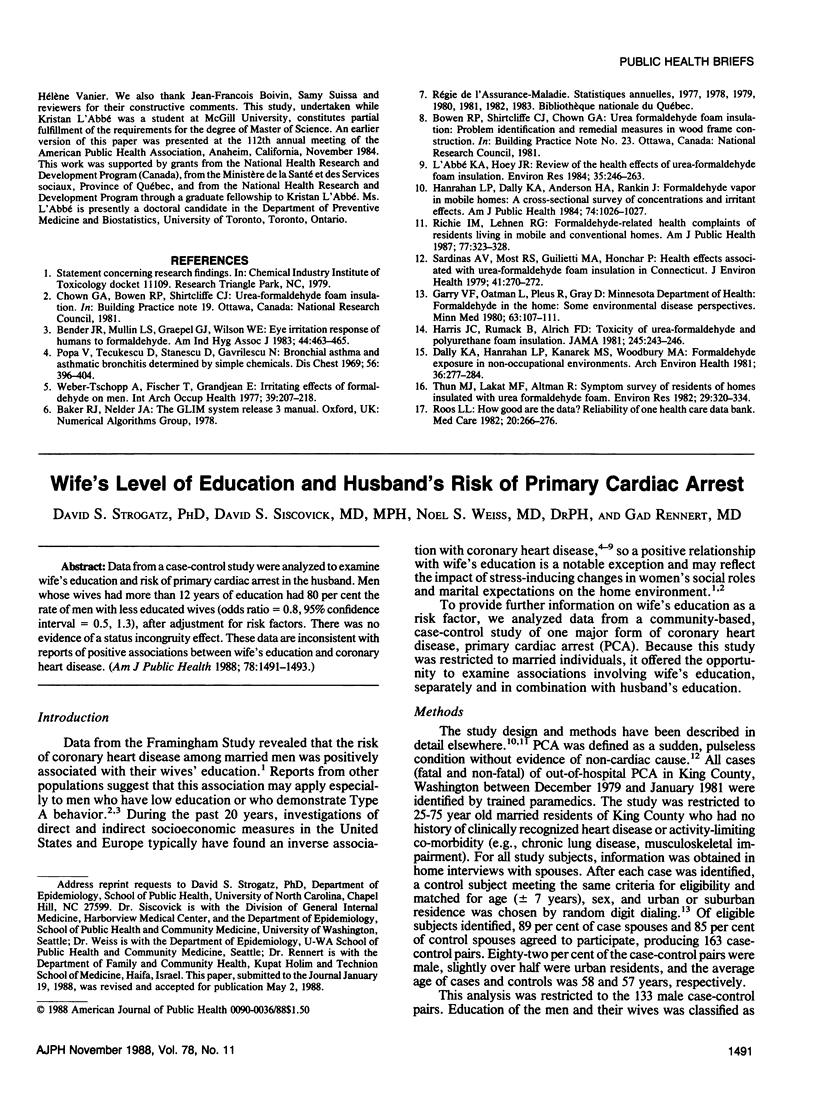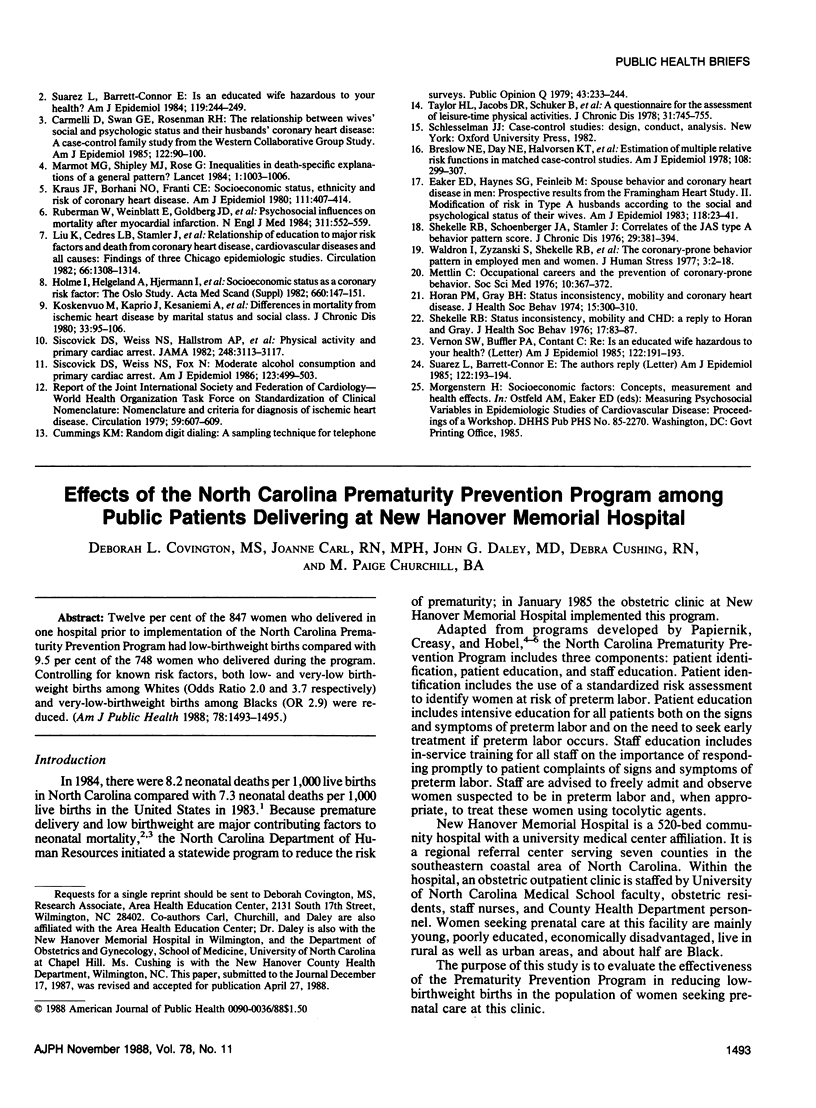Abstract
Data from a case-control study were analyzed to examine wife's education and risk of primary cardiac arrest in the husband. Men whose wives had more than 12 years of education had 80 per cent the rate of men with less educated wives (odds ratio = 0.8, 95% confidence interval = 0.5, 1.3), after adjustment for risk factors. There was no evidence of a status incongruity effect. These data are inconsistent with reports of positive associations between wife's education and coronary heart disease.
Full text
PDF


Selected References
These references are in PubMed. This may not be the complete list of references from this article.
- Breslow N. E., Day N. E., Halvorsen K. T., Prentice R. L., Sabai C. Estimation of multiple relative risk functions in matched case-control studies. Am J Epidemiol. 1978 Oct;108(4):299–307. doi: 10.1093/oxfordjournals.aje.a112623. [DOI] [PubMed] [Google Scholar]
- Carmelli D., Swan G. E., Rosenman R. H. The relationship between wives' social and psychologic status and their husbands' coronary heart disease. A case-control family study from the Western Collaborative Group Study. Am J Epidemiol. 1985 Jul;122(1):90–100. doi: 10.1093/oxfordjournals.aje.a114089. [DOI] [PubMed] [Google Scholar]
- Eaker E. D., Haynes S. G., Feinleib M. Spouse behavior and coronary heart disease in men: prospective results from the Framingham heart study. II. Modification of risk in type A husbands according to the social and psychological status of their wives. Am J Epidemiol. 1983 Jul;118(1):23–41. doi: 10.1093/oxfordjournals.aje.a113614. [DOI] [PubMed] [Google Scholar]
- Haynes S. G., Eaker E. D., Feinleib M. Spouse behavior and coronary heart disease in men: prospective results from the Framingham heart study. I. Concordance of risk factors and the relationship of psychosocial status to coronary incidence. Am J Epidemiol. 1983 Jul;118(1):1–22. doi: 10.1093/oxfordjournals.aje.a113611. [DOI] [PubMed] [Google Scholar]
- Holme I., Helgeland A., Hjermann I., Leren P. Socio-economic status as a coronary risk factor: the Oslo study. Acta Med Scand Suppl. 1982;660:147–151. doi: 10.1111/j.0954-6820.1982.tb00370.x. [DOI] [PubMed] [Google Scholar]
- Horan P. M., Gray B. H. Status inconsistency, mobility and coronary heart disease. J Health Soc Behav. 1974 Dec;15(4):300–310. [PubMed] [Google Scholar]
- Koskenvuo M., Kaprio J., Kesäniemi A., Sarna S. Differences in mortality from ischemic heart disease by marital status and social class. J Chronic Dis. 1980;33(2):95–106. doi: 10.1016/0021-9681(80)90033-8. [DOI] [PubMed] [Google Scholar]
- Kraus J. F., Borhani N. O., Franti C. E. Socioeconomic status, ethnicity, and risk of coronary heart disease. Am J Epidemiol. 1980 Apr;111(4):407–414. doi: 10.1093/oxfordjournals.aje.a112915. [DOI] [PubMed] [Google Scholar]
- Liu K., Cedres L. B., Stamler J., Dyer A., Stamler R., Nanas S., Berkson D. M., Paul O., Lepper M., Lindberg H. A. Relationship of education to major risk factors and death from coronary heart disease, cardiovascular diseases and all causes, Findings of three Chicago epidemiologic studies. Circulation. 1982 Dec;66(6):1308–1314. doi: 10.1161/01.cir.66.6.1308. [DOI] [PubMed] [Google Scholar]
- Marmot M. G., Shipley M. J., Rose G. Inequalities in death--specific explanations of a general pattern? Lancet. 1984 May 5;1(8384):1003–1006. doi: 10.1016/s0140-6736(84)92337-7. [DOI] [PubMed] [Google Scholar]
- Mettlin C. Occupational careers and the prevention of coronary-prone behavior. Soc Sci Med. 1976 Jul-Aug;10(7-8):367–372. doi: 10.1016/0037-7856(76)90092-5. [DOI] [PubMed] [Google Scholar]
- Ruberman W., Weinblatt E., Goldberg J. D., Chaudhary B. S. Psychosocial influences on mortality after myocardial infarction. N Engl J Med. 1984 Aug 30;311(9):552–559. doi: 10.1056/NEJM198408303110902. [DOI] [PubMed] [Google Scholar]
- Shekelle R. B., Schoenberger J. A., Stamler J. Correlates of the JAS Type A behavior pattern score. J Chronic Dis. 1976 Jun;29(6):381–394. doi: 10.1016/0021-9681(76)90059-x. [DOI] [PubMed] [Google Scholar]
- Shekelle R. B. Status inconsistency, mobility and CHD: a reply to Horan and Gray. J Health Soc Behav. 1976 Mar;17(1):83–87. [PubMed] [Google Scholar]
- Siscovick D. S., Weiss N. S., Fox N. Moderate alcohol consumption and primary cardiac arrest. Am J Epidemiol. 1986 Mar;123(3):499–503. doi: 10.1093/oxfordjournals.aje.a114265. [DOI] [PubMed] [Google Scholar]
- Siscovick D. S., Weiss N. S., Hallstrom A. P., Inui T. S., Peterson D. R. Physical activity and primary cardiac arrest. JAMA. 1982 Dec 17;248(23):3113–3117. [PubMed] [Google Scholar]
- Suarez L., Barrett-Connor E. Is an educated wife hazardous to your health? Am J Epidemiol. 1984 Feb;119(2):244–249. doi: 10.1093/oxfordjournals.aje.a113743. [DOI] [PubMed] [Google Scholar]
- Taylor H. L., Jacobs D. R., Jr, Schucker B., Knudsen J., Leon A. S., Debacker G. A questionnaire for the assessment of leisure time physical activities. J Chronic Dis. 1978;31(12):741–755. doi: 10.1016/0021-9681(78)90058-9. [DOI] [PubMed] [Google Scholar]
- Vernon S. W., Buffler P. A., Contant C. Re: "Is an educated wife hazardous to your health"? Am J Epidemiol. 1985 Jul;122(1):191–194. doi: 10.1093/oxfordjournals.aje.a114077. [DOI] [PubMed] [Google Scholar]
- Waldron I., Zyzanski S., Shekelle R. B., Jenkins C. D., Tannebaum S. The coronary-prone behavior pattern in employed men and women. J Human Stress. 1977 Dec;3(4):2–18. doi: 10.1080/0097840X.1977.9936816. [DOI] [PubMed] [Google Scholar]


